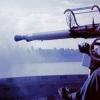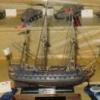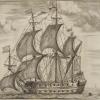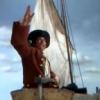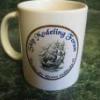Supplies of the Ship Modeler's Handbook are running out. Get your copy NOW before they are gone! Click on photo to order.
×
-
Posts
841 -
Joined
-
Last visited
Reputation Activity
-
 michaelpsutton2 got a reaction from CaptainSteve in Mutiny on the Bounty
michaelpsutton2 got a reaction from CaptainSteve in Mutiny on the Bounty
Great point "Weather clothes" could have interfered with the use of oars..........
-
 michaelpsutton2 got a reaction from avsjerome2003 in Seeking information on determining load waterline
michaelpsutton2 got a reaction from avsjerome2003 in Seeking information on determining load waterline
Mathew Bakers famous sail plan for a galleon of 1596 seems to show where he wanted her to float. The earliest named plan in the NMM the Tryumph of 1698 has a load line indicated
-
 michaelpsutton2 got a reaction from druxey in Seeking information on determining load waterline
michaelpsutton2 got a reaction from druxey in Seeking information on determining load waterline
All of the old methods produced rough approximations. Some were rougher than others. Shipbuilding was an art not a science until the middle of the eighteenth century.The ships were built to displace something more than the actual weight of their intended contents and could then be ballasted down the design load water line for stability. If you want a snapshot of just how well this worked in the real world, consult "Great ships" by Frank Fox. See how many of the ships, particularly the 1st, 2nd, & 3rd rates required girdling or padding the frames to increase the displacement. So many ships could hardly open the lower tier ports when they were at anchor much less at sea.
This subject interests me and I would love a chance to read the paper when you are done
-
 michaelpsutton2 reacted to trippwj in Seeking information on determining load waterline
michaelpsutton2 reacted to trippwj in Seeking information on determining load waterline
I am working on a paper concerning the process used to determine the load waterline in the 16th through mid 19th centuries and could use some help.
I have found an abundance of information concerning the application of Archimedes' principle on buoyancy and displacement, but to date I have only been able to find where it was applied to determine the actual displacement of a vessel when already in the water. The primary sources I have checked thus far (such as Sutherland, Steel, Humphreys, Mungo Murray, Stalkart etc. - still working through many, and have not gotten far in the works in other languages such as French and Italian, though they were far ahead of the English in adopting scinetific methods) all discuss the waterline but, rather than describe how to determine the level, they provide a set value. I came across this from The Sea-Man’s Vade Mecum: Containing the Most Necessary Things for Qualifying Seamen of All Ranks. Printed and Sold by James Woodward behind the Royal-Exchange (1707):
...the true way of Measure, must be by measuring of the Body and Bulk of the Ship under Water, for if one Ship be longer in the Floor than another of the same Breadth and Length, she shall be more in Burthen than the other; as a Flemish Ship shall carry more than a French or Italian Vessel of the same Length or Breadth; therefore, I say, the Measure of a Ship is known by measuring her, as a piece of Timber may be measured of the Form, to the draught of the Water, assign'd her, the weight of the same Body of the same Water that the Ship swimmeth in, shall be the exact Weight of the Ship, and all things therein, Loading, Rigging, Victuals included therein: then if the Ship be measured to her light Mark, as she will swim at being launched, the Weight of so much Water being taken or subtracted from the Weight of the Water when she is laden, the Residue shall be the Weight that must load Ability of carrying, called her Burthen. By this means you may know the Weight of the Ship light, and what she will carry to every Foot of Water assigned to her, which can be done by no general Rules in Arithmetick, because of their great Irregularity, according to the differing Forms of Ship; you may, if you please, first measure the Content of the Keel, Post, Stem and Rudder, all of it that is without the Plank, and under the Water-line, and note it by it self; then measure the Body of the Ship in the Mid-ships, by multiplying of the depth of the Water-line, and the breadth; then you may find the Content of the Want by the circular part of the Ship under Water, being narrowed downward, and subtract this from the whole Content of the Body found, by the depth of the Water-line and breadth of the Ship, and this shall be the solid Content of that part of the Ship, I mean, of solid Foot Measure, of 1728 Inches to the Foot; then proceed to the fore part or after part of a Ship, and to 3 or 4 Timbers more, find the mean Breadth at the narrowing aloft at the Waterline, and allow at the Floor and the mean Depth, and measure that piece of the Ship, as I told you of the middle part of the Ship, and so measure the whole Ship by pieces, and add them together; and so many Feet as it maketh, so many Feet of Water shall be the Weight of the said Ship, and the Reason may be considered thus: There is a Ponderosity in the Water, but there is a greater in the Air; and there is a Ponderosity in the Water it self, but not so much as in other things more solid, as in Iron: Suppose a Gun or an Anchor of Iron it sinketh in the Water, but yet is not so heavy in the Water as in the Air, by the weight of so much Water as shall make a Body equal to the Body of a Gun, or an Anchor in Magnitude; which Weight substracted [sic] from the Weight of the Iron Body weighed in the Air, and so much must be the Weight of it in the Water.
While it encompasses both Aristotlean (for example, There is a Ponderosity in the Water, but there is a greater in the Air; and there is a Ponderosity in the Water it self, but not so much as in other things more solid, as in Iron: Suppose a Gun or an Anchor of Iron it sinketh in the Water, but yet is not so heavy in the Water as in the Air, by the weight of so much Water as shall make a Body equal to the Body of a Gun, or an Anchor in Magnitude; which Weight substracted [sic] from the Weight of the Iron Body weighed in the Air, and so much must be the Weight of it in the Water) and Archimedes concepts (then if the Ship be measured to her light Mark, as she will swim at being launched, the Weight of so much Water being taken or subtracted from the Weight of the Water when she is laden, the Residue shall be the Weight that must load Ability of carrying, called her Burthen.), I have not found where designers, in crafting the model and plans, applied these concepts.
I find some reference to this in works by Deane and Chapman, but most of what I find is actually descriptive of finding the stability of a vessel.
Have any of you come across any treatises prior to the late 1700's where the principle of buoyancy was applied during the design stage to find the load waterline, or was most of it based on institutional knowledge?
Appreciate any leads or insights - and THANKS!
-
 michaelpsutton2 got a reaction from jud in Mutiny on the Bounty
michaelpsutton2 got a reaction from jud in Mutiny on the Bounty
I am familiar with those log entries. It was always my impression that the "weather clothes" were intended to provide addition freeboard not for shade. I think he would have said "awnings" which was a term on common usage back then. I could be wrong
-
 michaelpsutton2 got a reaction from CaptainSteve in Mutiny on the Bounty
michaelpsutton2 got a reaction from CaptainSteve in Mutiny on the Bounty
I am familiar with those log entries. It was always my impression that the "weather clothes" were intended to provide addition freeboard not for shade. I think he would have said "awnings" which was a term on common usage back then. I could be wrong
-
 michaelpsutton2 reacted to popeye2sea in Constitution "Mystery Skylight"
michaelpsutton2 reacted to popeye2sea in Constitution "Mystery Skylight"
I went aboard the ship today to search out the deck prisms. These are let into the gun deck to focus light down into the berth deck. There are a few of them located in the officers berthing area (ward room) aft on the berth deck. As you can see they are hexagonal and flat on top and shaped like a prism from below. By the way the extra shoring beams are there in preparation for the upcoming dry docking.
Here is the top of one on the gun deck just forward of the Captains cabin.
And here is from below:
Regards,
-
 michaelpsutton2 got a reaction from ScottRC in The Old Depot Museum in Vicksburg, MS
michaelpsutton2 got a reaction from ScottRC in The Old Depot Museum in Vicksburg, MS
I had a chance to visit the "Old Depot Museum in Vicksburg". I am not sure that it is really a museum, but it is a fine collection of models and a splendid diorama of the battle of Vicksburg. I would really describe it as a showcase for an outstanding group of model builders. There are train models and memorabilia as well. I suggest that anyone passing through that great southern city take the time tostop by there.
-
 michaelpsutton2 got a reaction from ccoyle in The Old Depot Museum in Vicksburg, MS
michaelpsutton2 got a reaction from ccoyle in The Old Depot Museum in Vicksburg, MS
I had a chance to visit the "Old Depot Museum in Vicksburg". I am not sure that it is really a museum, but it is a fine collection of models and a splendid diorama of the battle of Vicksburg. I would really describe it as a showcase for an outstanding group of model builders. There are train models and memorabilia as well. I suggest that anyone passing through that great southern city take the time tostop by there.
-
 michaelpsutton2 got a reaction from mtaylor in The Old Depot Museum in Vicksburg, MS
michaelpsutton2 got a reaction from mtaylor in The Old Depot Museum in Vicksburg, MS
I had a chance to visit the "Old Depot Museum in Vicksburg". I am not sure that it is really a museum, but it is a fine collection of models and a splendid diorama of the battle of Vicksburg. I would really describe it as a showcase for an outstanding group of model builders. There are train models and memorabilia as well. I suggest that anyone passing through that great southern city take the time tostop by there.
-
 michaelpsutton2 got a reaction from michael20 in The Old Depot Museum in Vicksburg, MS
michaelpsutton2 got a reaction from michael20 in The Old Depot Museum in Vicksburg, MS
I had a chance to visit the "Old Depot Museum in Vicksburg". I am not sure that it is really a museum, but it is a fine collection of models and a splendid diorama of the battle of Vicksburg. I would really describe it as a showcase for an outstanding group of model builders. There are train models and memorabilia as well. I suggest that anyone passing through that great southern city take the time tostop by there.
-
 michaelpsutton2 got a reaction from uss frolick in The Old Depot Museum in Vicksburg, MS
michaelpsutton2 got a reaction from uss frolick in The Old Depot Museum in Vicksburg, MS
I had a chance to visit the "Old Depot Museum in Vicksburg". I am not sure that it is really a museum, but it is a fine collection of models and a splendid diorama of the battle of Vicksburg. I would really describe it as a showcase for an outstanding group of model builders. There are train models and memorabilia as well. I suggest that anyone passing through that great southern city take the time tostop by there.
-
 michaelpsutton2 got a reaction from trippwj in Dutch Warships in the Age of Sail, 1600-1714: Design, Construction, Careers, and Fates
michaelpsutton2 got a reaction from trippwj in Dutch Warships in the Age of Sail, 1600-1714: Design, Construction, Careers, and Fates
Just rec'd my copy of this book by James Bender. This volume is very similar to the four volume series British Warships in the" Age of Sail".
There are listings for all of the major Dutch warships of the period. There are pleny of Van de Velde drawings and paintings. Unfortunately there are only a couple of plans because the Dutch did not use plans in the way that the English did.
The book will make a fine addition to my bookshelf and the introductory price on Amazon is more than fair.
I had hoped for a little more information on Dutch rigging and fitting practices though. I don't have nearly the same quality of sources as I do for English ships.
-
 michaelpsutton2 got a reaction from Farbror Fartyg in Dutch Warships in the Age of Sail, 1600-1714: Design, Construction, Careers, and Fates
michaelpsutton2 got a reaction from Farbror Fartyg in Dutch Warships in the Age of Sail, 1600-1714: Design, Construction, Careers, and Fates
Just rec'd my copy of this book by James Bender. This volume is very similar to the four volume series British Warships in the" Age of Sail".
There are listings for all of the major Dutch warships of the period. There are pleny of Van de Velde drawings and paintings. Unfortunately there are only a couple of plans because the Dutch did not use plans in the way that the English did.
The book will make a fine addition to my bookshelf and the introductory price on Amazon is more than fair.
I had hoped for a little more information on Dutch rigging and fitting practices though. I don't have nearly the same quality of sources as I do for English ships.
-
 michaelpsutton2 got a reaction from mtdoramike in Soldering Trouble
michaelpsutton2 got a reaction from mtdoramike in Soldering Trouble
When soldering keep a wet sponge on your bench. Wipe the tip of the iron on the sponge after each application. The tip sould stay shiny and coatede smoothly with solder. If the solder beads up on the tip it needs cleaning. The soldering iron shoud not be used to melt the solder. It is used to heat the work piece until it is hot enough to melt the solder itself. Solder will not flow from a hot piece to a cooler piece. Press the iron on the work piece hard enough to transfer the heat. The more surface area of contac between the two the better.
Apply the solder as far away from the soldering iron tip as possible. If the work piece is hot enough the solder will melt and flow towards the soldering iron
-
 michaelpsutton2 got a reaction from SaturnV in Swan Class Masts and Spars versus Mermaid Class
michaelpsutton2 got a reaction from SaturnV in Swan Class Masts and Spars versus Mermaid Class
One potential difference between the spars of Swan's and Mermaids might be wouldings on the lower masts. I am not really sure how big a vessel had to be in order for wouldings to be used.
-
 michaelpsutton2 got a reaction from trippwj in Swan Class Masts and Spars versus Mermaid Class
michaelpsutton2 got a reaction from trippwj in Swan Class Masts and Spars versus Mermaid Class
One potential difference between the spars of Swan's and Mermaids might be wouldings on the lower masts. I am not really sure how big a vessel had to be in order for wouldings to be used.
-
 michaelpsutton2 got a reaction from druxey in Were ship figureheads routinely removed?
michaelpsutton2 got a reaction from druxey in Were ship figureheads routinely removed?
I have read that many of the British "tea clippers", in the 1860's & 1970's would remove their figureheads, put covering boards over the scroll work on the trailboards and paint over the brass rails during long passage to and from the east. When they neared port all of the decorative work would be revealed again.
But this is a very specific trade and and very limited period. These ship were in a lucrative, high prestige trade where appearance was very important. This was during the time when the results of the annual tea races was front page news. I doubt if this happened often in common merchantmen or naval vessels.
It's hard to remember but I think you can find references to this practice in the journals of the captain of the tea clipper Ariel if you can find a copy.
-
 michaelpsutton2 got a reaction from WackoWolf in Soldering Trouble
michaelpsutton2 got a reaction from WackoWolf in Soldering Trouble
When soldering keep a wet sponge on your bench. Wipe the tip of the iron on the sponge after each application. The tip sould stay shiny and coatede smoothly with solder. If the solder beads up on the tip it needs cleaning. The soldering iron shoud not be used to melt the solder. It is used to heat the work piece until it is hot enough to melt the solder itself. Solder will not flow from a hot piece to a cooler piece. Press the iron on the work piece hard enough to transfer the heat. The more surface area of contac between the two the better.
Apply the solder as far away from the soldering iron tip as possible. If the work piece is hot enough the solder will melt and flow towards the soldering iron
-
 michaelpsutton2 got a reaction from JPett in Soldering Trouble
michaelpsutton2 got a reaction from JPett in Soldering Trouble
When soldering keep a wet sponge on your bench. Wipe the tip of the iron on the sponge after each application. The tip sould stay shiny and coatede smoothly with solder. If the solder beads up on the tip it needs cleaning. The soldering iron shoud not be used to melt the solder. It is used to heat the work piece until it is hot enough to melt the solder itself. Solder will not flow from a hot piece to a cooler piece. Press the iron on the work piece hard enough to transfer the heat. The more surface area of contac between the two the better.
Apply the solder as far away from the soldering iron tip as possible. If the work piece is hot enough the solder will melt and flow towards the soldering iron
-
 michaelpsutton2 got a reaction from src in Soldering Trouble
michaelpsutton2 got a reaction from src in Soldering Trouble
When soldering keep a wet sponge on your bench. Wipe the tip of the iron on the sponge after each application. The tip sould stay shiny and coatede smoothly with solder. If the solder beads up on the tip it needs cleaning. The soldering iron shoud not be used to melt the solder. It is used to heat the work piece until it is hot enough to melt the solder itself. Solder will not flow from a hot piece to a cooler piece. Press the iron on the work piece hard enough to transfer the heat. The more surface area of contac between the two the better.
Apply the solder as far away from the soldering iron tip as possible. If the work piece is hot enough the solder will melt and flow towards the soldering iron
-
 michaelpsutton2 got a reaction from JerseyCity Frankie in Bobstay for bowsprit on Sherbourne?
michaelpsutton2 got a reaction from JerseyCity Frankie in Bobstay for bowsprit on Sherbourne?
I cannot speak to how or why any particular set of plan were prepared. The model company my be in possession of specific information for that exact vessel. But attached are the pic's of English cutters I have in my records. They all have bobstays. I just cannot imagine such a long, rather thin spar being in effect "unstayed". It is especially hard to see how it would work considering the relative sizes of the head sail in a cutter rig. Something would have to counteract the upward pull of the sails.
-
 michaelpsutton2 got a reaction from tkay11 in Bobstay for bowsprit on Sherbourne?
michaelpsutton2 got a reaction from tkay11 in Bobstay for bowsprit on Sherbourne?
The earliest I think is from the 1763 group but most are later
-
 michaelpsutton2 got a reaction from dashi in Colors on ships
michaelpsutton2 got a reaction from dashi in Colors on ships
Recently the microscopic traces of paint remaining on the Vasa were analyzed. The results are interesting and at least to my eye unexpected. Lots and lots of bright colors for sure. These pics represent the museum's current best guess.
-
 michaelpsutton2 got a reaction from uss frolick in Colors on ships
michaelpsutton2 got a reaction from uss frolick in Colors on ships
The only other "real" chunk of carving from the 17th century is the coat fo arms from the Royal Charles of 1655. She was captured by the Dutch in 1667 and broken up in the 1670's. The coat of arms from her stern now hangs in the Rijks museum. It is multi-colored but faded And I cannot tell how bright the colors once may have been





